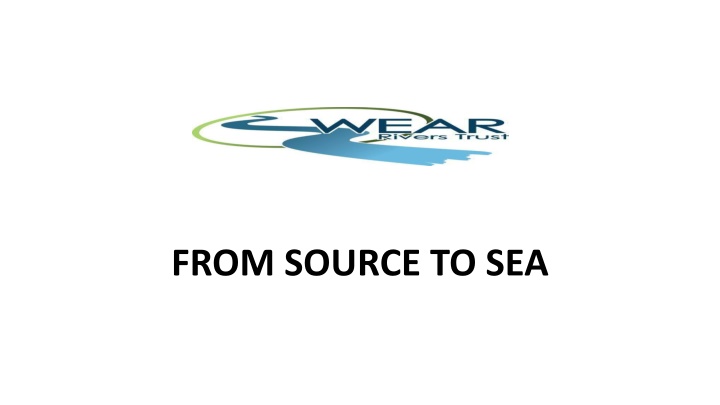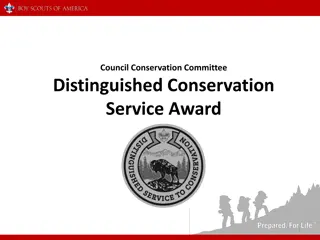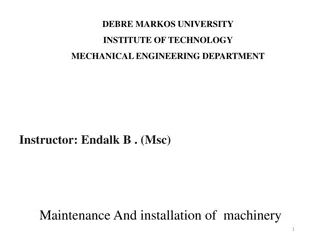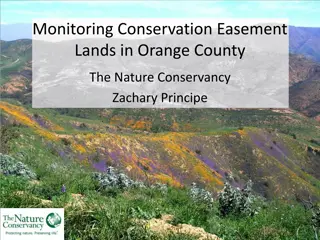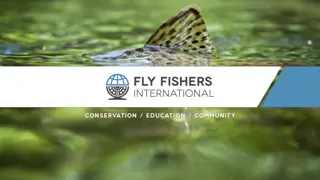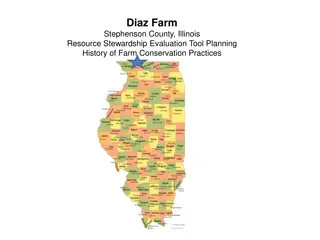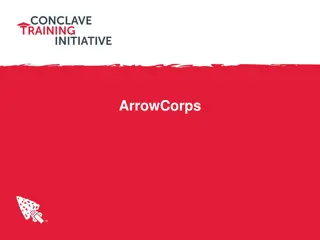Conservation Efforts for the River Wear Landscape and Watercourses
A charity's primary objective is to conserve and protect the Wear catchment area, including landscape, rivers, and watercourses. They work to rehabilitate polluted mining sediments and improve aquatic environments. The charity aims to educate the public on the importance of river conservation and catchment management while respecting the historical context of the region.
Download Presentation

Please find below an Image/Link to download the presentation.
The content on the website is provided AS IS for your information and personal use only. It may not be sold, licensed, or shared on other websites without obtaining consent from the author.If you encounter any issues during the download, it is possible that the publisher has removed the file from their server.
You are allowed to download the files provided on this website for personal or commercial use, subject to the condition that they are used lawfully. All files are the property of their respective owners.
The content on the website is provided AS IS for your information and personal use only. It may not be sold, licensed, or shared on other websites without obtaining consent from the author.
E N D
Presentation Transcript
Who are we We are charity who s main objective is to conserve, protect and rehabilitate and improve the landscape, rivers, streams, watercourses and water impoundments of the Wear catchment, Co-Durham including Weardale, the lower Wear and adjacent estuarine and coastal areas and waters. The catchment starts at Killhope in Upper Weardale following the Wear to Sunderland where the river meets the sea. We are based at Low Barns Nature Reserve near Bishop Auckland and have 6 members of staff and a great team of volunteers who help with a wide range of activities in and around the Wear and its many subsidiaries. The secondary objective of the Trust is to advance the education of the public, any association, company, local authority, administrative or government agency in the understanding of rivers, corridors and catchments, including their fauna, flora and economics or social activity, and river catchment management, and to provide a greater understanding as to the need and benefits of conversation, protection, rehabilitation and improvement of aquatic environments.
The River Wear The River Wear rises in the east Pennines and is formed at Wearhead from the confluence of Killhope Burn and Burnhope Burn. The Wear has a catchment area of just over 1080km2 and has a number of large tributaries including the River Browney and the River Gaunless. At its source the landscape is dominated by blanket bog, heather and grass moorland and is shaped by hill faming and management for grouse. As the river heads east the land is mostly in agricultural use, sheep and upland cattle rearing in the west moving into mixed arable farming in the east. The landscape is heavily influenced by its industrial and mining past and while most of the mines are now redundant, some industry remains in the lower reaches of the catchment. The Wear flows through a number of urban areas including the city of Durham before it reaches the sea at Sunderland.
So what does our work entail: Fluorite (also known as fluorspar) crystal was mined in Weardale and had a variety of uses including being used in steel production to lower the melting point of the raw materials which allows for impurities to be removed, to produce enamel, cooking utensils and certain types of glass. The history of fluorspar mining in the region began in 1882 and finally finished in 1999, with the closure of the Frazer Hush Mine. So what has flourspa got to do with the river? Weardale now is home to numerous abandoned metal mines and its long history has now left polluted sediments in the river and in floodplain soils. Utilising investigations completed by the Trust and funded by the Environment agency in 2015-16 the Coal Authority is funding a 2 year programme commissioned at the start of 2018, running to 2020 to contain heavy metal-rich mining sediments released into the Killhope and Middlehope sub catchments and thereby into the wider river system through the collapse of industrial revolution infrastructure and more frequent heavy rainfall/high flow events attributed to climate change. The Trust is working with local mine historians, specialist ecologists, Durham County Council Archaeology Team, Historic England, and Natural England to ensure that the works are not only effective in containing sediments, but fully respect these complex sites' sensitive environmental and historical context and in some areas legal protected status.
As we move down the catchment from the source in Upper Weardale we have various issues to address and through various funding streams we are working on or have completed the following projects: River Gaunless for People and Wildlife Project A partnership project led by the Trust and supported by Groundwork North East & Cumbria and Daisy Arts, through the Gaunless Local Management Group, focussed on re-connecting on young people, including those from the Gypsy Roma Traveller Community with their river and introducing young people from the settled community to GRT culture. The project delivers a combination of river and environmental awareness, practical conservation tasks and environmentally themed artistic activity. The project began in July 2017 and will be completed in February 2019. The main project funder is Heritage Lottery Fund, with supplementary funding from Northern Heartlands and Bishop and Shildon Area Action Partnership Magnesian Limestone Rural Diffuse Pollution Project Funded by the Environment Agency 2017/18, a total of six north-east Durham farmers who farm land on the Magnesian Limestone aquifer were provided with a free farm visit to identify opportunities to minimise the risk of surface and groundwater pollution. The visits identified opportunities which included improving soil structure, reducing runoff from fields, tracks and yard areas, livestock and nutrient management. The project led to the identification of 28 opportunities being identified which will be carried forward for delivery on receipt of future funding. The Trust has worked with partners, Frontier Agriculture, Seaham Grange Farm, Northumbrian Water and Durham Heritage Coast Partnership to promote the business and environmental of more targeted and "smarter" integrated land and water management.
Greening the Twizell Project Funded by The Environment Agency 2017/18 a total of 0.24ha of new wetland habitats were created along the Twizell Burn above Grange Villa to reduce sedimentation of instream habitats and provide natural flood management benefits downstream. This involved lots of voluntary support from local groups and individual volunteers in carrying out scrub clearance, creating silt traps and planting wetland plants. Two fish easements were installed on in-channel structures downstream of Grange Villa improving access to 5km of high quality spawning habitat for all species of fish. EU Interreg North Sea Region: Topsoil Project The Trust's first European project 2015-2020 in partnership with Durham University and Northumbrian Water. The aim is to more fully understand the interaction between surface and ground water, particularly, but not exclusively as this affects the Magnesian Limestone aquifer, an important source of drinking water. The project has concentrated on the impact of farming and on coastal Hawthorn and Cut Throat Denes and Herrington and Twizell Burns as study areas. Desk top and field data collection is continuing with analysis of pollution sources and pathways with Storymaps being used to collate and communicate complex inter-related concepts. Living Waterways Twizell Burn Project Funded by the Environment Agency, Stanley Town Council, Durham County Council and Postcode Lottery 2016-18 this two-year multi-faceted project worked alongside the local community to enhance the freshwater environment in the Stanley, South Moor and Quaking Houses area through the creation of 0.755ha of wetland habitats, restoration of 0.29ha of deteriorated watercourses, contributing to reduced flood risk downstream. Volunteers, co-ordinated through the Greening Twizell Partnership, supported the project through the creation of leaky dams, wetland plug and tree planting. Volunteers helped uncover a buried 1950's paddling pool, fed by the colliery water system, which was recorded and broken up to allow the re-instatement of a meander identified from historical maps over a 100m section of burn flowing through South Moor Memorial Park. The realigned channel was crossed by 2 new footbridges and accessed by a re-aligned and re-surfaced footpath. A community archaeology project, with professional support researched the mining history of South Moor Colliery, which had previously occupied the project site and surrounding area was completed, particularly looking at the colliery's water management system. The project incorporated information and memories from retired miners and local historians
Living Waterways Lumley Park Burn Project Funded by Sunderland City Council, Environment Agency, Par Petroleum and Little Lumley Parish Council, 2015-18, a total of 2.357 kms of fencing has been installed along Rainton and Moors Burn, with drinking points, excluding grazing animals allowing the recovery of bankside vegetation, reducing sediment inputs, and to create berm earthworks to narrow an over-widen channel to create habitat promote more consistent in-channel flows. Volunteer activity along the burn has included tree planting, bank protection, balsam pulling and litter picks. Brancepeth Beck Fish Passage Project Funded by the Environment Agency, a 6th fish passage improvement, building on works delivered in previous years, was delivered at Goodwell Ford to open up promotively 5km of high quality spawning and nursery habitat for all species of fish. The rock ramp was installed in September 2017. Ongoing monitoring will be carried out by a Durham University PhD student researching industrial stream recovery in the North East. Visual passage assessments and redd counting was carried out during November and December 2017, by a team of volunteers and students. Redd counting confirmed migratory salmonids were able to reach Brancepeth Castle once again due to completion of easements on golf course in 2016/17. These works cumulatively have allowed miEducation & Riverfly Education & Riverfly Funded by Heritage Lottery Fund and Greggs Community Challenge 20117/18. Educational activity is currently primarily centred around Stanley and Bishop Auckland to tie in with Trust projects in these areas. A total of six schools were involved in riverfly monitoring this year. In Stanley the Trust worked with two schools delivering Riverfly monitoring and Mayfly in the classroom, with a further school from outside the area visiting the habitat creation/restoration works in Langley Moor Plantation/Memorial Park in Stanley as part of their topic on flooding. In Bishop Auckland five primary schools were identified for a joint approach with the fire and police services to reduce anti-social behaviour. A further two primary schools in Bishop Auckland are participating in riverfly monitoring. Long standing relationships are maintained with a number of primary schools, outside of current project areas.
Alderdene Burn Natural Flood Management Funded by Durham County Council and Northumbrian Water the Trust are working with Durham University and local landowners to design natural flood management techniques throughout the Alderdene Burn catchment a tributary of the Smallhope Burn, flowing through and posing a long standing risk to Lanchester. Durham University are mapping the Alderdene catchment using drone flyovers and creating 3D models which will be used to model rainfall and natural flood management scenarios. On completion of the design study in September 2018 priority interventions such as hedgerow planting, ditches, swales and leaky dams will then be installed to compliment hard flood protection works being delivered by Durham county council in the centre of Lanchester. The Trust, funded by Northumbrian Water will work to establish a Smallhope-Browney Local Management Group, based around Lanchester in 2018/19 to encourage local participation and leadership in project development and delivery, building on the strong local interest in flood risk. So to Sunderland, where the Wear meets the North Sea ..
Sunderland where the Wear meets the sea Water what happens to the empty bottles? Litter discarded in the catchment carried by the river to The sea
Scientists at Ghent University in Belgium recently calculated that shellfish lovers are eating up to 11,000 plastic fragments in their seafood each year. We absorb fewer than 1%, but they will still accumulate in the body over time. The findings affect all Europeans, but, as the most voracious consumers of mussels, the Belgians were deemed to be most exposed. Britons should sympathise last August, the results of a study by Plymouth University caused a stir when it was reported that plastic was found in a third of UK-caught fish, including cod, haddock, mackerel and shellfish. Now, UK supermarkets are being lobbied to create plastic-free aisle by the campaign group A Plastic Planet, as a feature-length documentary. We are finally paying attention to the pollution that has plagued our seas for years the government is considering a refundable deposit on plastic bottles, and pharmaceutical company Johnson & Johnson recently switched from plastic to paper stems on its cotton buds. It is a problem throughout the Wear catchment as well as being a world wide problem and although litter on our beaches contribute to the problem as does litter in our countryside. Said litter reaches our rivers and makes its way to the sea SO WHAT CAN WE DO - - - - - Swap our plastic milk cartons for returnable good old fashioned glass milk bottles Take a refillable cup to our favourite coffee shop Look for recyclable packaging when doing your weekly shop Discard of rubbish in bins Volunteer on local litter picks
Who we work with. Hosting the Wear Catchment Partnership The Trust continues its role as host for the Wear Catchment Partnership established in 2011 through the Catchment Based Approach "A community-led approach that engages people and groups from across society to help improve our precious water environments. CaBA Partnerships are now actively working in 100+ catchments across England and Wales." (www.catchmentbasedapproach.org ). The Partnership aims to deliver a healthy rural and urban Wear catchment through integrated land and water management, flexibly addressing the multiple historic industrial and modern development pressures on the river system, delivered through public and voluntary sector and widest business partnership working underpinned by active community participation. Healthy river catchments provide enjoyment and well-being for people; rich and diverse wildlife; and support positive economic development. A Catchment Partnership Business Plan (2017-2030) has been written which aims to "..plan, co-ordinate and deliver integrated environmental projects, delivering multiple benefits with greatest efficiency. By 2030 the historic and modern challenges across the River Wear catchment will have been identified and actions taken, or planned, to restore the whole catchment to the best possible condition." It is planned to create a Catchment Sustainability Officer position to implement, report on progress made through the plan, to co-ordinate review of partner and overall catchment priorities and to ensure the future sustainability of the Partnership through supplementing annualised Defra funding.
How can you get involved.. Get involved in the Wear Catchment Partnership Get involved with Local Management Groups Corporate Sponsorship Become a volunteer Donate For more information, please contact Kirstie Hutchinson Wear Rivers Trust, Low Barns Nature Reserve, Witton-le-Wear, Bishop Auckland, Co-Durham DL14 0AG Tel: 01388 488867 Email: admin@wear-rivers-trust.org.uk Website: wearriverstrust.org.uk You can also find us on Facebook, Twitter and Instagram
